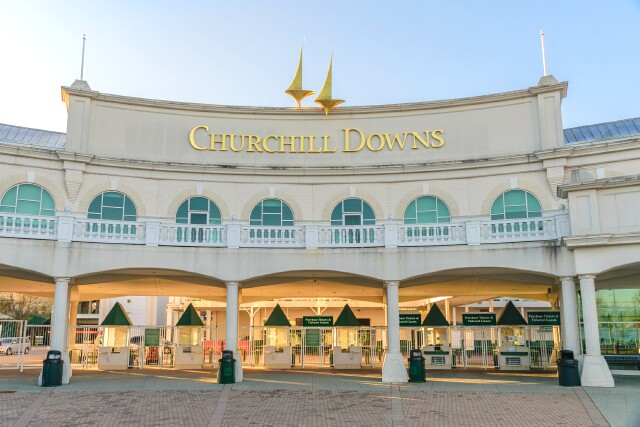The HISTORY Channel's Moment in Media: The Kentucky Derby Rides the Radio Airwaves

The 51st Kentucky Derby was run on May 16, 1925, and after a largely sunny afternoon it was a wet, sloppy track at Churchill Downs when the horses took off from their gates. Even more important, it was history in the making, and not just because Flying Ebony, an underdog who'd never before won a stakes race, ridden by a jockey who'd recently suffered a serious accident, won. It was also -- 98 years ago this month -- the first time the world's premier Thoroughbred contest was aired live on the radio. An estimated five million listeners tuned in nationwide to hear a broadcast originating from WHAS in Louisville.
Coincidentally, that year was also the first time the race was dubbed the "Run for the Roses," by Bill Corum, a columnist for The New York Evening Journal and The New York Journal-American.
The Derby, often referred to as "the most exciting two minutes in sports," is considered the longest-running sporting event in the United States, held annually since 1875, and its longevity is uninterrupted. The World Series, by contrast, started in 1903, and was skipped in 1994 due to a players' strike; the big golf tournaments began in the early 20th century and skipped years during World War II.
But, then, the Derby is proudly committed to its traditions: the lavish hats, the mint juleps, the crowds of spectators singing "My Old Kentucky Home," the blanket of roses draped over the winning horse. (Even that "Run for the Roses" phrase is now a registered trademark owned by Churchill Downs.)
It traces its origins to 1872, when Meriwether Lewis Clark Jr., the grandson of famed explorer William Clark (and named for Clark's expedition companion), went to Europe and visited famous horse racing tracks like England's Epsom Downs. When he came back to Kentucky, he founded the Louisville Jockey Club, and his uncles Henry and John Churchill donated the land for what would become Churchill Downs. While in England the 12th Earl of Derby gathered his friends for the Derby Stakes, Clark envisioned gathering Louisville's fashionable set for a local equivalent. And so the template was set: On May 17, 1875, about 10,000 spectators attended the first Kentucky Derby and watched 15 three-year-old Thoroughbreds race for 1.5 miles. The winner was a horse named Aristides, with a time of 2:37.75.
The famous traditions developed over those early years. The name Churchill Downs was first used in 1883. In 1896, the course was shortened to its current distance of 1.25 miles. In 1904, the red rose became the official flower of the Kentucky Derby, and in 1930 the term "Triple Crown" was first used to describe the honor of winning the Derby, the Preakness Stakes and the Belmont Stakes. (The first time that trio of victories occurred, though, was 1919.) For the next year, 1931, the Derby settled into its permanent calendar slot: the first Saturday in May.
The Derby was broadcast internationally for the first time in 1932, on BBC Radio in the United Kingdom, and in 1949 it first reached television, airing locally on WAVE in Louisville. In 1952, it went national, broadcast by CBS on 44 stations.
It's now a broadcasting behemoth. In 2022, 19 million viewers tuned in to watch on NBC. And on Saturday, May 6, this year, the network's national coverage kicked off at noon Eastern, which ran for seven and a half hours. In the end, it all came down to two minutes of racing with a final come-from-behind victory for the 2023 Kentucky Derby winner, Mage.
Click the social buttons to share this content with your friends and colleagues.
The opinions and points of view expressed in this content are exclusively the views of the author and/or subject(s) and do not necessarily represent the views of MediaVillage.com/MyersBizNet, Inc. management or associated writers.

